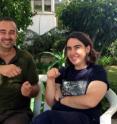Architecture of chromosomes: A key for success or failure
In a pioneer study published in the latest issue of the scientific journal Nature Communications, a research team at the Instituto Gulbenkian de Ciência (IGC; Portugal), led by Miguel Godinho Ferreira in collaboration with Isabel Gordo, show for the first time that chromosomes rearrangements (such as inversions or translocations) can provide advantages to the cells that harbor them depending on the environment they are exposed. This study contributes to better understand different biological problems such as: how cancer cells that have chromosomal rearrangements can outgrow normal cells or how organisms may evolve in the same physical location to form distinct species. Chromosomal rearrangements consist in parts of a chromosome being relocated to another region of the same chromosome or to a different one. These mutations are commonly found in cancer cells, but also exist in individuals that do not present any known disease. Until now it was unknown the impact that chromosomal rearrangements have in the fitness of an organism, i.e. in its ability to survive and reproduce. The team of Miguel Godinho Ferreira has proposed to answer this question.
Using as a model organism the African beer yeast, Schizosaccharomyces pombe (S. pombe), the research team observed that chromosomal rearrangements occur in natural populations of yeast. To better investigate the effect these mutations have in the ability of yeast to grow, the researchers engineered yeast strains with segments of chromosomes allocated to different regions, without disrupting the expression of any gene, thus keeping an identical genetic code.
Surprisingly, even though they all contained the same genetic information, mutant strains had different growth abilities, showing that some of the chromosomes rearrangements were beneficial whereas others were deleterious. More than that, when the environment where the strains were growing is changed, the apparently deleterious rearrangement could become beneficial, favoring the growth of that particular strain. Based on these observations, the research team proposed that natural selection tailors the chromosome structure to a particular environment.
The pressing question was why did these mutant strains that contained exactly the same DNA sequence and genes, behave so differently? The researchers observed that the activation and expression of genes would differ in the different strains, and this could just result from the new location brought by the rearrangement of the chromosomes.
Ana Teresa Avelar, first author of the paper, says: "Our yeast chromosome variants have exactly the same DNA sequence. We have just changed the location of chromosomal sequences. Therefore, our experiments show for the first time the effects brought by changes in chromosomal architecture."
Miguel Godinho Ferreira adds: "We can now infer how cancer cells that have chromosomal rearrangements can adapt and grow better than normal cells; how humans with different chromosome variants may have fertility problems without being aware of this; how these chromosomal rearrangements can be kept in natural populations without becoming extinct. And new questions originate from this work. Crucially, since chromosomal rearrangements occur spontaneously in nature, could they be the starting step at the origin of a new species?"
Source: Instituto Gulbenkian de Ciencia
Other sources
- Architecture of chromosomes: A key for success or failurefrom Science DailyFri, 23 Aug 2013, 15:00:18 UTC
- Architecture of chromosomes: A key for success or failurefrom Science BlogFri, 23 Aug 2013, 13:30:16 UTC
- Scientists discover that chromosomal rearrangements can be advantageousfrom PhysorgFri, 23 Aug 2013, 9:30:31 UTC
